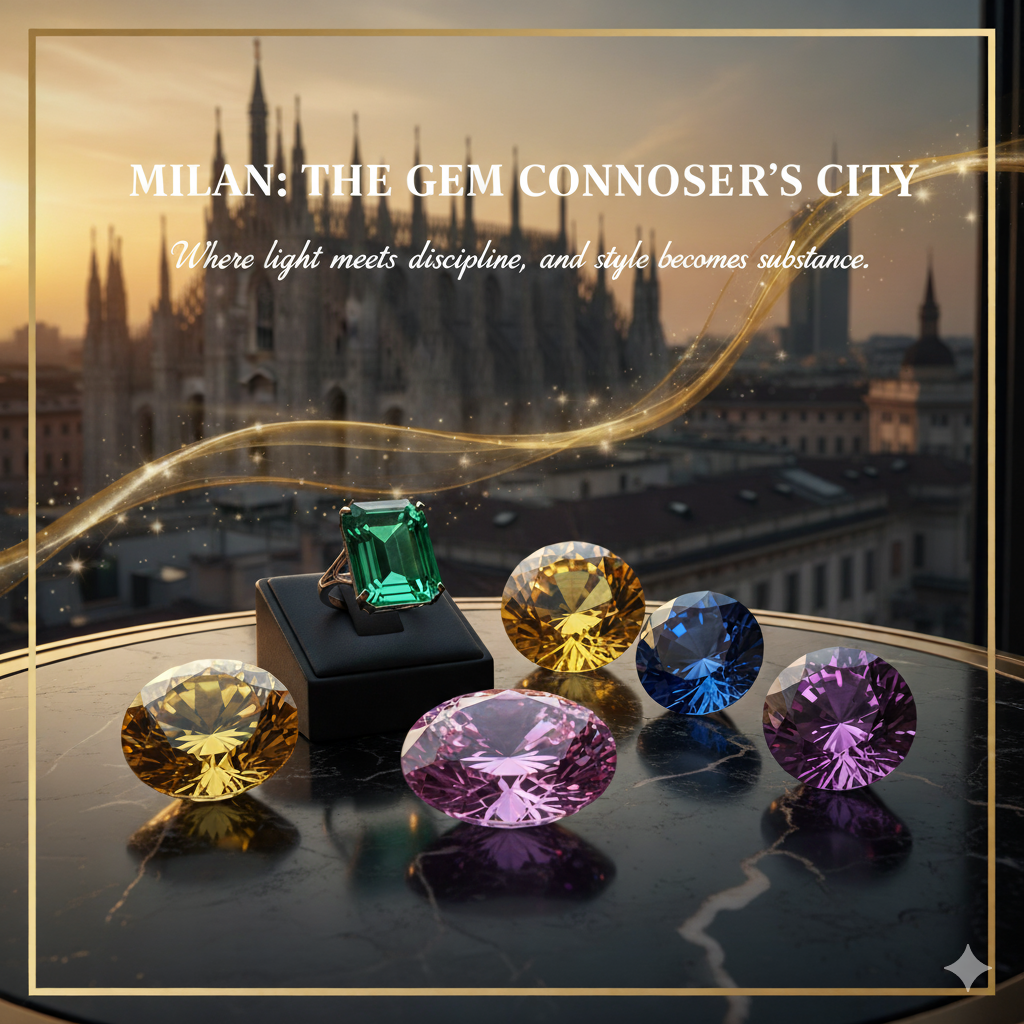Milan: The Gem Connoisseur’s City
Where light meets discipline, and style becomes substance.
1) The City That Polishes Time
There are cities that dream and cities that make.
Milan belongs to the second kind.
It doesn’t dazzle instantly like Paris or seduce like Florence; it refines — slowly, quietly, precisely — until every curve of gold and every glint of gem feels inevitable.
For centuries, Milan has been Europe’s atelier of order — the place where beauty is engineered, not exaggerated.
From the architecture of the Duomo to the tailoring of Via Montenapoleone, Milan’s genius lies in discipline disguised as grace.
And in that discipline lies its relationship with gemstones — not as symbols of status, but as studies in perfection.
2) From Renaissance Guilds to Modern Workshops
In the Renaissance, Milan’s goldsmiths were revered across Lombardy.
They crafted reliquaries, chalices, and royal insignias for dukes and cathedrals, blending Gothic delicacy with humanist precision.
By the 18th century, these workshops evolved into botteghe d’arte — family studios where craftsmanship was passed like inheritance.
Names like Buccellati and Marchisio began appearing on silver and gold pieces whose engraving alone could take weeks.
To this day, the Buccellati “rigato” engraving — microscopic striations that give metal a silk-like texture — remains one of Milan’s proudest artistic techniques.
3) The Post-War Spark
After World War II, when Florence and Rome rebuilt their artistic industries, Milan rebuilt its confidence.
Designers like Gianmaria Buccellati, Pomellato, and Gio Caroli began blending Italian craftsmanship with urban modernism.
While Paris perfected haute couture, Milan perfected wearable brilliance — jewelry that looked architectural yet emotional, rational yet romantic.
By the 1960s, the Milanese school of jewelry had become its own movement: minimalist lines, confident gold, and gems chosen for personality, not just perfection.
4) The Milanese Eye — What Sets It Apart
Milan’s connoisseurs don’t merely buy gems; they curate them.
The Milanese aesthetic can be summarized in three words:
Proportion. Purity. Purpose.
- Proportion — Every gem is weighed not just by carats but by balance.
- Purity — Inclusions are not flaws but stories; a gem must “breathe.”
- Purpose — The design must allow light and life to pass through.
It’s an attitude born of architecture — where form follows function, and elegance follows restraint.
5) Bulgari, Buccellati, Pomellato — The Holy Trinity of Italian Light
Though Rome gave birth to Bulgari, its northern cousin Milan shaped Italy’s intellectual jewelry identity through Buccellati and Pomellato.
Buccellati
- Founded in 1919, its style is rooted in Renaissance texture — lace-engraved gold, honeycomb filigree, and gemstone contrasts.
- Milan is its beating heart, where master artisans spend months engraving one cuff or carving gemstone-backed gold like lace.
- Collectors call Buccellati jewels “frozen opera.”
Pomellato
- Founded in 1967, Pomellato revolutionized Milanese style by creating “ready-to-wear luxury.”
- Colored gemstones — garnet, tourmaline, topaz — were set in warm rose gold, accessible yet poetic.
- It was Milan’s declaration that elegance didn’t need an occasion.
Together, these houses made Milan synonymous with quiet luxury, decades before the phrase existed.
6) The Connoisseurs Themselves
In Milan, taste is inherited like property.
Collectors are rarely flamboyant — they prefer the intimacy of salons, private viewings in Brera apartments, and one-of-a-kind commissions discussed over espresso.
The Milanese buyer values understatement.
Where New York buys diamonds for size, Milan buys them for character — the warmth of a Kashmir sapphire, the mood of a smoky tourmaline, the texture of a pearl’s skin.
As one gem dealer famously said:
“In Milan, they don’t ask how big. They ask how true.”
7) The Hidden Gem Markets
Behind the storefront glamour lies the Quartiere Orefici, the historic goldsmith district near the Duomo, where tiny ateliers polish global treasures.
Many supply stones to international houses quietly, never signing their names.
Here, Burmese rubies and Sri Lankan sapphires are examined under skylight, not spotlight.
Dealers speak in half-sentences; every nod is a contract.
It’s not secrecy — it’s ritual respect for rarity.
8) Academia and Craft
Milan is also home to Italy’s leading jewelry institutions — the Politecnico di Milano’s Design Faculty and the Scuola Orafa Ambrosiana, where students learn gemmology alongside ethics and sustainability.
This fusion of art and science fuels the city’s modern-day jewelry intelligence — the reason Milan’s designs feel engineered for emotion.
9) Gemstones as Architecture
The Milanese treat gemstones the way architects treat marble: as light given form.
Every ring or pendant is a small cathedral of proportion.
Emeralds are set like windows; sapphires are framed, not hidden.
The result is jewelry that feels structural yet soft, much like Milan’s skyline — clean lines, glowing interiors, and restrained ornamentation.
10) From Catwalks to Cases
Jewelry here doesn’t exist apart from fashion — it completes it.
During Milan Fashion Week, fine jewelry exhibitions align with couture shows, making gems part of a living narrative of design.
When Prada or Armani introduces pearl or gemstone accents, they are referencing the same Milanese logic: precision as poetry.
11) The Emotional Economy
A Milanese gem purchase is rarely impulsive.
Collectors often visit a piece several times before acquiring it — watching how it behaves in daylight, evening light, and reflection.
For them, buying is listening.
They believe a gem must choose its owner — a philosophy not unlike India’s traditional gem astrology, making Milan one of the few Western cities that truly understands emotional gem ownership.
12) The Modern Era — Green Gold and Conscious Glamour
Today, Milan leads Europe’s movement toward ethical sourcing and sustainable luxury.
Workshops now use recycled gold, lab certification, and traceable gems, merging conscience with craft.
This new “Etico Lusso” (ethical luxury) redefines status: not what you wear, but how responsibly you wear it.
13) The Milan–India Parallel
There’s a poetic symmetry between Milan and Jaipur.
Both are cities of artisans, not factories.
Both balance heritage and modernity, stone and soul.
Both see jewelry not as fashion but as language.
When PreciousCarats speaks of curation and emotional connection, Milan would nod — it speaks the same dialect of quiet connoisseurship.
14) PreciousCarats Reflection — Why Milan Matters
For PreciousCarats, Milan stands as proof that luxury can be disciplined.
It teaches that beauty is not in brilliance alone, but in the patience behind it — the ability to let a gem reveal itself slowly.
Where the world rushes to sell, Milan waits to understand.
And in that waiting, light becomes art.
15) Closing — The Stillness Behind the Sparkle
Milan may not shout like Paris or glimmer like Dubai, but its light is older — studied, human, patient.
It is the light that architects sculpt, that goldsmiths engrave, and that collectors wear quietly, without need for validation.
Every sapphire that passes through Milan carries the city’s fingerprint:
a calm certainty that true beauty is never hurried.

